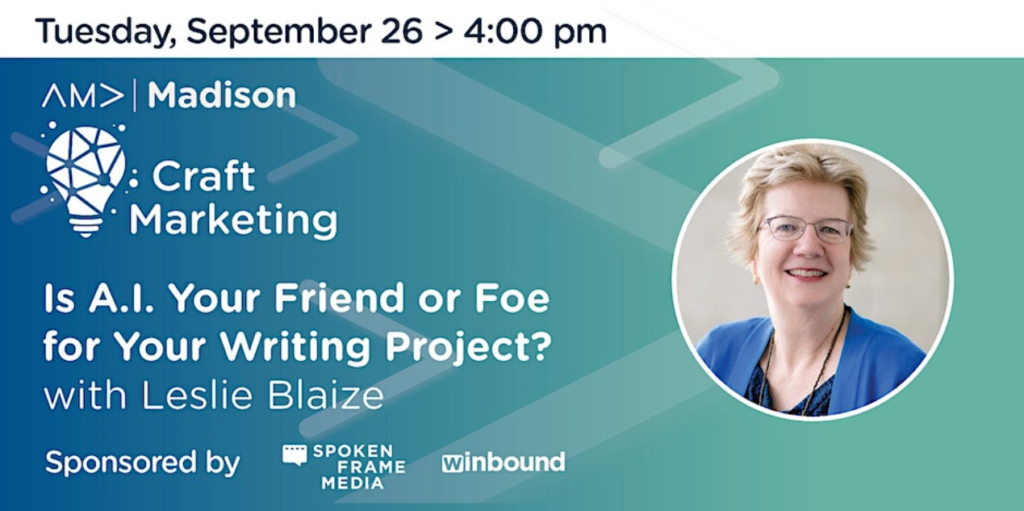With the rise of generative AI tools like ChatGPT, Jasper, Bing AI, and many more, the question of “Will AI make me obsolete?” has been on many marketers’ minds. For writing-focused marketers, the panic is even more anxiety-inducing.
Leslie Blaize, a certified professional services marketer with Blaize Communications, acknowledged this concern at Craft Marketing’s September 26 event. But she shared some good news: AI can’t replace good writing to engage readers. That’s because it lacks:
❌ Sensory detail
❌ Empathy
❌ Emotional intelligence
❌ Creativity
❌ A brand-aligned voice
❌ Strategy
❌ Personal anecdotes
❌ Consistent accuracy and factuality
❌ The ability to interview subject matter experts effectively or pose follow-up questions
As Leslie explained, the catch is that not all decision-makers will understand these faults. Some may lose their jobs. Times change and the method you use to accomplish a task today might not exist in a few years – this isn’t new, and it’s beyond our control.
But what we can do is evolve our skills to embrace AI. Read on to get Leslie’s best advice on why marketers should adopt AI in their writing and her top five tips for best results.
Why Marketers Should Use AI
AI is a valuable tool for marketers, as it can help ease the process of:
- Content creation via brainstorming, outlines, and research (as long as you fact-check)
- Predictive analytics
- Targeted ads
- Summarize long reports
- Email optimization
- Persona development
- Headline and email subject line ideas
Collaborating with AI to perform these tasks can help us increase productivity, leaving us with more time for rewarding work involving creativity and strategy.
Plus, AI know-how will help us if we find ourselves on the job hunt. Employers are already beginning to list AI proficiency on job descriptions, so it’s best to start training now.
5 Tips for Making the Most of AI in Your Writing
1. Make Your Prompts Specific with Frameworks
If you talk to AI tools like ChatGPT the same way you input searches into Google, you’ll get low-quality answers. That’s why prompt engineering skills are so vital. To get started, Leslie suggests telling AI tools to formulate its answers using these frameworks:
- AIDA: A common sales copy framework that stands for Grab Attention, Generate Interest, Increase Desire, and Move the Reader to Action.
- Blog Post Framework: This refers to the framework of Opener, Key Takeaway, Examples, Call to Action, and Conclusion.
- The 4 U’s for Headlines: This framework stands for Urgent, Useful, Unique, and Ultra-Specific.
AI should be familiar with these frameworks, so you can name-drop one of these options, and it should respond accordingly. And when you find a prompt that works well for you, share it with your coworkers. They may use it as-is or as a jumping-off point to create more well-formulated prompts.
2. Learn to Collaborate Effectively with AI
As we explored in the opening of this blog, AI has a long list of shortcomings alongside its strengths. But it also has pitfalls, like the tendency to state inaccurate information as fact, cross ethical boundaries, and intellectual property infringement. To safeguard against these risks and compensate for AI’s weaknesses, humans need to collaborate effectively with AI.
To mitigate risk, include a human in the loop at every stage. This could consist of working with your legal team to establish AI guidelines regarding intellectual property. (Leslie recommends checking out Marketing AI Institute’s website for more details.)
Additionally, beware of publishing AI-developed content without fact-checking and humanizing it first (more on that in tip #3!) Otherwise, copyright infringement, misinformation, or just plain disjointed-sounding copy is in your future.
Aside from risk, collaboration is also necessary for you to write quality content. For example, when writing a case study, human input is vital, but you can accelerate the process if you delegate specific tasks to AI:
- Your Tasks: Select a happy client to meet strategic goals, interview and connect with them, write a case study on-brand, and humanize any content AI comes up with.
- AI’s Tasks: Identify prospect challenges, create an outline, edit content, and recommend headlines.
3. Help AI Understand Your Writing Style
If you’ve tried using AI, you know the “AI voice” it writes with. It’s unmistakable, and there’s a good chance we’ll see it out in the wild as some companies decide to replace their writers with ChatGPT.
You can avoid this in two ways. First, and this one’s a non-negotiable, you need to proofread everything AI spits out. Fact check it, tweak it until it reads like your writing voice, and add any client or employee anecdotes, subject matter expert or survey quotes, or other personal touches you can.
Second, a trick Leslie learned from AI expert Frank Mendoza is giving AI examples of your best writing. Then, ask it to describe your writing and tone and use that description verbatim the next time you prompt AI to write something up for you. You can then train AI to use this writing style in the future. Sure, it won’t perfectly replicate your style, so you’ll still have to humanize its content, but it’ll give you a head start.
4. Understand Your Audience On A Deeper Level
AI can also help you see things from your audience members’ unique perspectives. Leslie suggests asking AI to write a diary entry from the perspective of someone with a specific role within a particular industry. You can command it to cover the imaginary person’s concerns, priorities, thought processes, etc. You can even describe a hyperspecific scenario, like:
“You’re the business owner of a manufacturing company. Write a diary entry describing your fears, concerns, and challenges regarding installing HVAC systems in your new Utah plant. What benefits are you expecting from hiring an HVAC owner’s representative? This firm has worked with you before.”
This exercise may open your awareness to new reservations or motivations you have never thought to include in your copy or buyer personas.
5. Create Stronger Corporate Quotes
Quotes are a press release staple and can go a long way in making your copy more lively. If you’re not thrilled by the one you came up with, however, AI can help. Leslie suggests Michael Smart PR’s strategy of drafting an engaging quote and asking AI to give you versions in five styles. These styles may include range from professional to concise. Additionally, provide AI guidance on tone, like personal but clear or using the announcement format. Then, take the best match and ask for five rewrites. Finally, present your favorite three to the person you’re quoting, and you’ll have your winner.
It’s Your Turn
Now, it’s time to play with AI and see what you can create collaboratively. It can make your work life more enjoyable, boost your productivity, and add an extra skill to your resume while you’re at it.
And for anyone who needs to hear it, here’s one more piece of advice from Leslie: Change can save you time and money; don’t fight it. Get expert advice and try out what makes the most sense for you and your organization.
See You at the Thirsty Goat for October’s Craft Marketing
Craft Marketing invites you to its next live in-person event at the Thirsty Goat in Fitchburg at 4:00 PM on October 24th, “Leveraging the Power of Social Media to Build Business and Local Community” presented by Otehlia Cassidy. You’ll get to network with your peers and enjoy a delicious beverage of your choice.
Registration Details to Come.
Thanks to our sponsors:
About the Author
Kara Martin, Content Writer at Naviant, specializes in written B2B content, from case studies to blogs and beyond. She transforms complex technical information into compelling, data-driven content that helps organizations turn their digital transformation goals into a reality.




